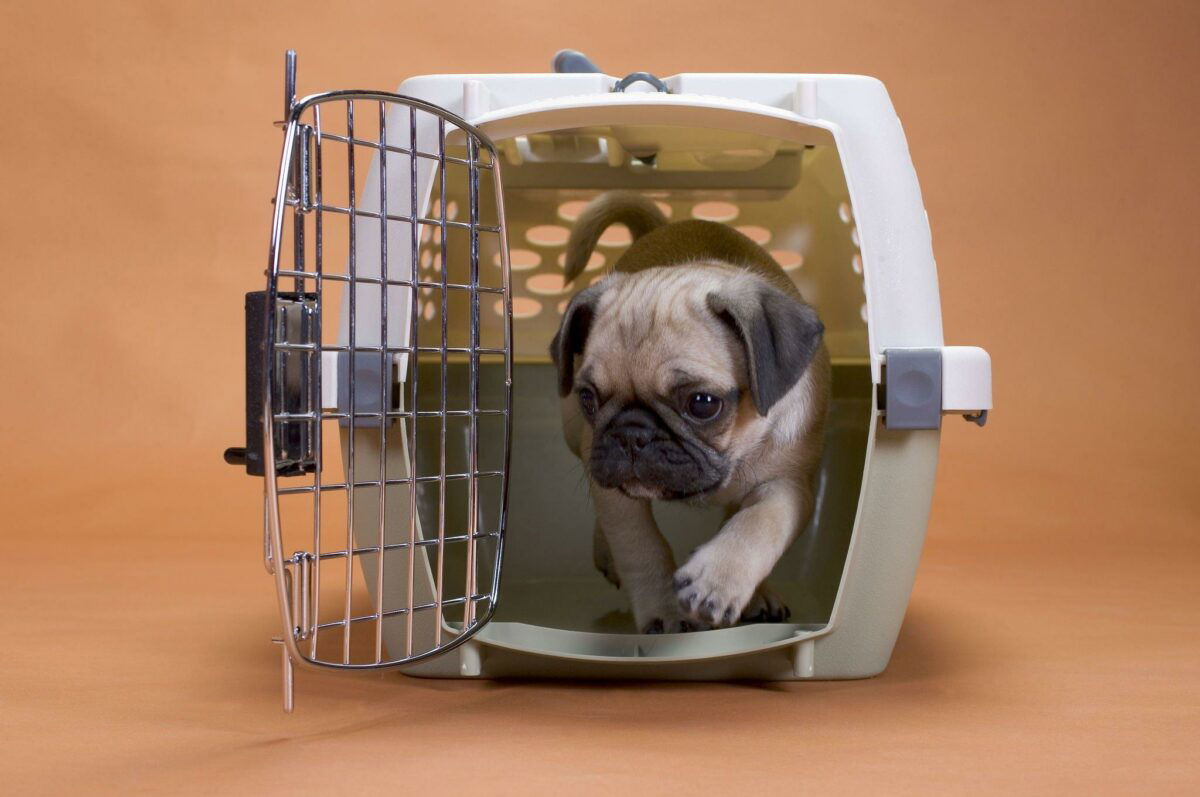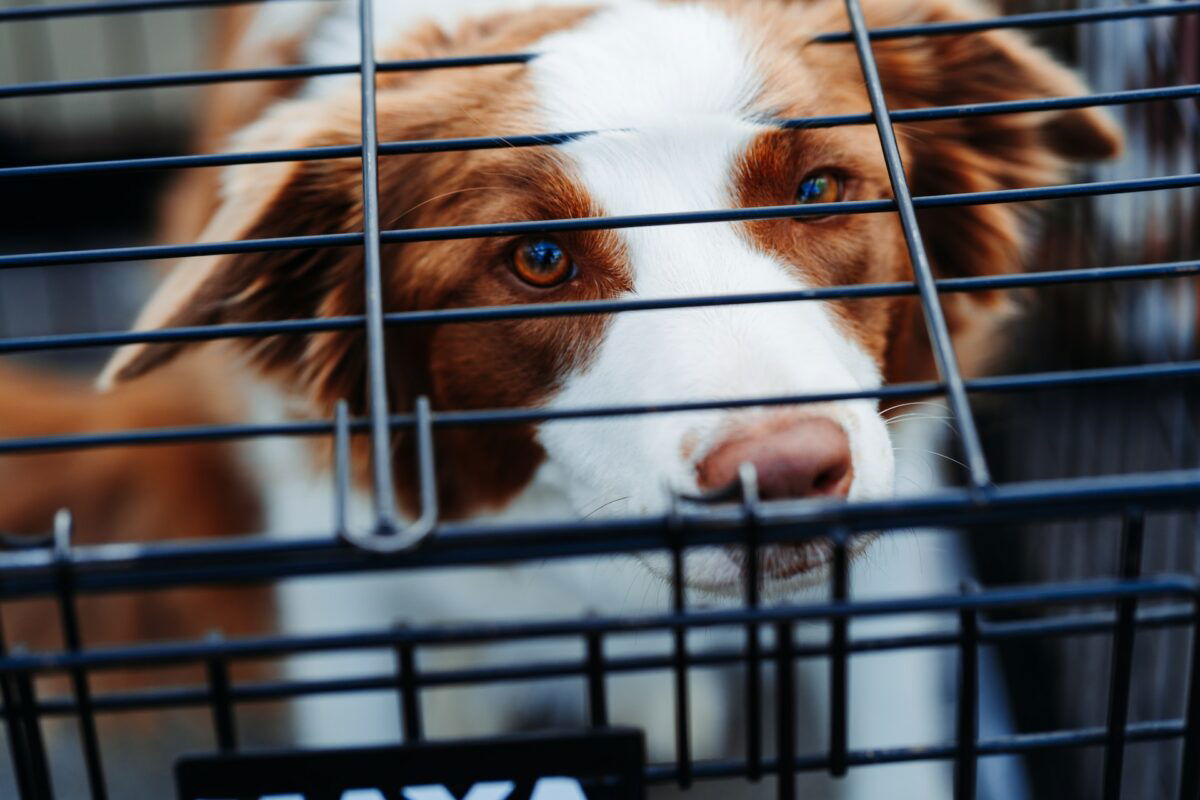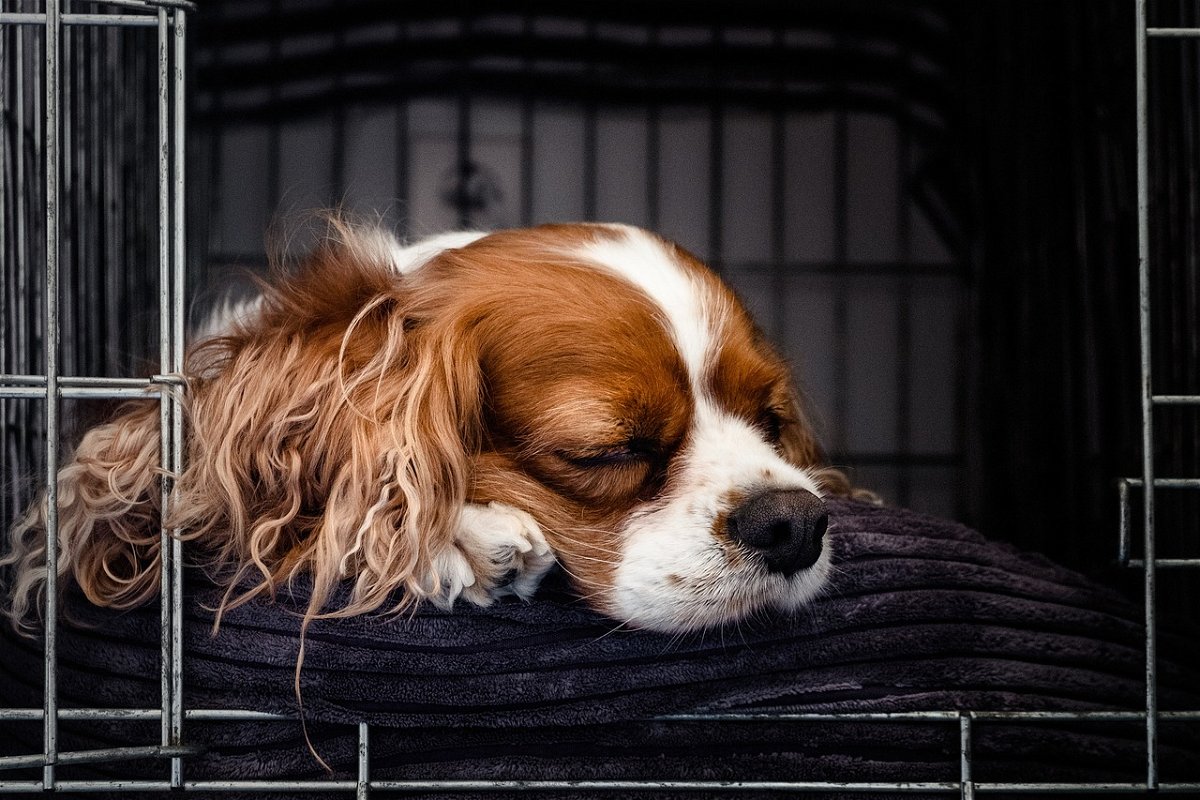We're an affiliate
We hope you love the products we recommend! Just so you know, we may collect a share of sales or other compensation from the links on this page at no additional cost to you. Thank you if you use our links, we really appreciate it!
Anxiety in dogs is a condition that should give pet parents a reason to worry. Maybe you’ve tried making a few changes to your dog’s routine, but that’s still not working out.
But, have you tried using a high-anxiety dog crate? And, do crates help dogs with anxiety?
The value of the good old doggy crates cannot be overstated. These tools help keep pups in a comfy environment while giving them a sense of privacy and belonging.
One thing that some pet parents may fail to appreciate is that dog crates can help reduce anxiety-related behavior in dogs.
Keep reading as we explore whether dog crates can help manage canine anxiety and some other ways you may want to consider.
What Is Dog Anxiety?
Katherine Houpt VMD, a James Law Professor Emeritus of Behavior Medicine at Cornell University, says that ‘canine anxiety’ is often used as a blanket statement for anything a dog does that the owner doesn’t like.
Canine anxiety is a complex behavior issue that drives dogs to show fear-related responses such as excessive barking, whining, and howling, among others.
If you’ve seen your dog exhibiting some strange behaviors, then there is a high chance that they’re experiencing emotional drain.
Anxiety in dogs can be caused by several reasons including loud noises, changes in daily routine, separation from their owner, territorial aggression, etc.
Managing dogs with anxiety can be a tall order especially when you don’t know the root cause of the problem.
Dr. Houpt puts it that there is also a high chance of dogs showing anxiety-related behavior stemming from other health conditions.
7 Types Of Anxiety in Dogs
Knowing the exact type of anxiety will help you in managing the situation. There are several types of anxiety in dogs, all of which might show in different forms, including:
1. Separation anxiety
Separation-related distress is shown when the dog feels stressed when separated from the rest of the human family.
Dogs with separation anxiety can bark, howl, pace, destroy furniture, or soil the house in some cases when they notice a family member departing from the house.

Dogs with this type of anxiety prefer to spend time with their human family, especially the primary caregiver, and they may also turn out to be clingy.
2. Social anxiety
Some dogs may fear being around unfamiliar people or other pets, making them emotionally disturbed when walking in a public place.
You can suspect your dog has social anxiety if they show avoidance behavior such as walking away when a visitor enters the house.
Both adult dogs and puppies can exhibit social anxiety depending on how well they were socialized from a tender age.
3. Resource guarding
Some dogs will bark or even attack someone who seems to take what the dog considers valuable to them.
Most dogs with these instincts will guard resources such as food, treats, toys, and personal spaces from humans and other pets.
Some pups may take resource guarding tendencies a notch higher by ‘claiming’ their favorite human caregiver and barking or biting potential threats.
Resource guarding is sometimes referred to as territoriality and it is widely a genetic condition although some dogs learn the behavior.
4. Illness-induced anxiety
Your dog’s stress and anxiety may be attributed to an illness that causes physical pain or mental discomfort.
Sick dogs who tend to have anxiety or depression may show extreme changes in behavior, aggression, nervousness, and too much whining.
We recommend reaching out to your vet immediately, once you suspect illness is the cause of your dog’s emotional instability.
5. Noise anxiety
Noise-sensitive canines may show fear-based reactions when they encounter loud noises such as thunderstorms, fireworks, and construction noises, among others.
The fear can manifest in behaviors such as trembling, hiding, barking, panting, whining, or even trying to escape into quiet zones.
There’s a vast spectrum of noise sensitivity in dogs, ranging from mild discomfort of unexpected sounds to severe noise phobia.
6. Travel Anxiety
Some dogs may show nervousness or anxiety-related behavior when taking long car rides, air travels, or making short trips to the vet.
Travel anxiety in dogs is shown by hesitation to enter the car, drooling, panting, shaking, or even vomiting during the travel.
The triggers for travel phobia can vary widely, from the motion of the vehicle to unfamiliar surroundings, or the anticipation of an undesirable destination, like a vet’s office.
7. Generalized anxiety disorder
General anxiety in dogs is a more persistent form of anxiety that isn’t necessarily linked to specific triggers, events, or stimuli.
Dogs with general anxiety may exhibit constant signs of nervousness and stress, such as excessive barking, chewing, or panting, even in everyday situations that don’t normally cause stress.
They may also show physical signs like shaking, restlessness, and digestive issues. This type of anxiety is often a result of past traumatic experiences, genetics, or lack of socialization.
The Effects of Dog Anxiety
Anxiety in dogs is a serious mental condition that should be addressed as early as possible.
If left unchecked, canine anxiety can escalate into depression, putting your lovely pup in more danger.
The compounded effects of bad emotional conditions in dogs can affect all aspects of the dog’s life including physical problems such as digestive and behavioral problems such as the advancement of negative habits.
Do Crates Help Dogs with Anxiety?
Dog crates are valuable tools that are used to provide a comfy den-like place for dogs to rest, play, and sleep.
In addition to creating a resting place, anti-anxiety crates can be used to manage anxiety-related conditions in canines.
You may ask how, well, this section explores the impact of using high-quality dog crates in shaping your dog’s emotional condition and behavior.
8 Reasons Why Crates Help with Dog Anxiety
1. Prevents separation anxiety
Dogs with separation anxiety can sink into distress and heightened anxiety when their favorite caregiver leaves them alone at home.
But not anymore with crate training. You can teach your furry friend to remain calm whether you’re in the house or not by mapping out a personal space in the form of a crate.
This will give you the leeway to leave your dog behind as you proceed to your short errands in town without predisposing them to nervousness.
Remember you should not leave your dog alone for extended periods. Knowing how long dogs can stay alone will help you manage your time or book a dog sitter in advance.
2. Provides a den-like environment
Dogs are instinctively wired to snuggle in a den like their ancestors when seeking warmth on a cozy sleeping surface.
That is exactly what a fully furnished dog crate offers, making them a good place to calm offended canines and allowing them to de-stress.
You can achieve a den-like environment by placing a comfy bed in the crate and topping it up with adequate bedding.
A secure den-like environment can calm fearful dogs and give them a reason to sleep without worrying about external triggers for stress.
3. Easy travels
Dogs who experience anxiety on car rides can benefit from plastic carriers to manage tension and fear-related problems.

Soft-sided travel crates are well padded from the inside and they have ventilated walls to regulate the temperatures for your pup passenger.
This helps to provide a consistent familiar environment for the dog throughout the journey, without subjecting them to lots of adjustments that can cause fear or aggression.
4. Cuts out the noise
A fully furnished indoor dog kennel can act as a noise buffer to keep your dog safe from the rumbling sounds of thunder or fireworks.
Enclosed crates made with sturdy materials such as hardwood and thick steel metal will help cancel out external noise that may induce your dog into fear or anxiety.
In addition to the sturdy construction, you can dampen the noise further by covering the sides of the crate with a heavy blanket, but remember to leave out vent spaces for sufficient airflow.
You can help in providing a super quiet and calmer environment for your dog by placing the crate in an insulated room with less human traffic.
5. Provides a personal space
A doggy crate is used to map out a personal place for your beloved canine friend within specific rooms at home.
This personal space can act as a haven for your dog to unwind the day’s activities, play with their favorite toys, self-groom, or just spend some ‘me time’.
Creating a personal space can be beneficial for dogs living in a multi-pet home, where competition can thrive among the furry members leading to resource-guarding tendencies.
A personal space can provide a healthier, calmer environment for each pup in your home and prevent the rise of conflict and anxiety due to shared resources.
6. Limits free roaming
Sometimes dogs can show anxiety-related responses because of the huge space available to freely roam within the house.
Providing a well-sized crate for your pooch can limit their roaming time, and this can prevent the progression of negative behaviors caused by anxiety.
A dog with a contained environment is less likely to move around the house engaging in destructive behavior such as chewing on items.

In as much as a crate can provide a contained environment for your pup, remember to use it positively and not as a punishment tool for bad behavior.
Keep in mind that your dog needs enough time every day to engage in physical and mental stimulation, so be sure not to enclose them in a crate for a long time.
7. Supports training
A dog crate is a must-have tool for pet parents who want to train their furry pals on behavioral issues and commands.
Your dog may show generalized anxiety disorder because they haven’t been trained on how to behave or they don’t know what’s expected of them.
Having the right-sized dog crate will help you during the training sessions and instill good habits in your dog, making them less anxious.
8. Managing overstimulation
Crate training can help dogs in a busy household when the environment gets heightened causing them fear and heightened anxiety.
A crate provides an environment for your dog to escape the buzzling activities of the house, to rest in a calm environment to prevent getting overstimulated.
Other Helpful Tips for Managing Dog Anxiety
In addition to crate training, there are several other methods you can use to manage your dog’s anxiety.
We recommend observing your dog’s behavior and narrowing it down to the exact type of anxiety to make the management process easier.
The following are some of the additional tips you can use to deal with your dog’s anxious behavior:
1. Provide plenty of exercise each day
A tired dog is a good dog! You should always strive to provide your furry friend with opportunities to play and exercise, either indoors or outdoors.
A dog who goes to bed with pent-up energy is likely to exhibit unwanted behavior which might take a toll on their mental health.
Exercise is not only about cutting down your dog’s energy, but it also improves their physical health and provides mental stimulation to keep them happy.
Taking your dog out for morning walks and evening runs is a good place to start, but don’t be limited by the activities you can offer them.
2. Anti-anxiety medication
In extreme situations where your dog is diagnosed with general anxiety disorder, your vet may recommend anti-anxiety medicines to tone down the condition.
Dr. Katherine Houpt says that most pet parents are usually late in booking a vet appointment for their dogs, and by the time they do so, the vet may prescribe medication to manage the worsening situation.
Some of the most common anti-anxiety drugs for dogs are:
- Alprazolam (Xanax)
- Buspirone
- Trazadone
- Lorazepam (Ativan)
- Fluoxetine (Reconcil or Prozac)
- Sertraline (Zoloft)
- Clomipramine (Clomicalm)
- Dexmedetomidine (Sileo)
- Lorazepam (Ativan)
These drugs work by reducing the levels of serotonin in the affected dog’s brain and putting them in a calm demeanor.
Most veterinarians agree that anti-anxiety medicines are not a cure-all solution for emotionally unstable dogs.
You should only use these drugs with an express prescription from your vet, and they should be complementary to consistent behavior modification techniques to help your dog live a happy life.
3. Creating a routine
Creating a manageable routine for your dog and sticking to it can be beneficial in reducing their fear-related reactions.
A dog who knows what is expected of them is less likely to bark out of fear or tremble when visitors come home.
You can reinforce a consistent routine by sticking to similar activities at the exact time each day.
Have a predictable routine for waking your dog up, feeding, playtime, petting, resting, and sleeping.
Frequently Asked Questions (FAQs)
1. Do all dog crates work in managing canine anxiety?
Not all dog crates are made equal! An anti-anxiety crate should be constructed with sturdy materials, and it should have an escape-proof design to prevent your dog from running away.
You should also choose the best-sized crate based on your dog’s breed, age, and preference.
It should not be too small to squeeze our dog, and neither should it be too large to give too much space for negative behavior.
2. My dog freaks out in a crate when I leave, what should I do?
Your dog is likely suffering from separation anxiety. You can help them by furnishing the crate to make it appealing and cozy.
Do this by adding a comfortable bed and additional bedding materials to provide a den-like environment for your pup.
With a fully equipped crate, you can start training your dog to be calm by themselves whether you’re at home or not.
Start by leaving them alone for shorter periods and extend the time while rewarding them for staying calm despite your absence.
Conclusion
So, do crates help dogs with anxiety? As we have seen, crate training is essential in managing anxiety responses in dogs.
As an affectionate pet parent, you should always monitor your dog and look for the worrying signs of emotional distress such as anxiety.
Knowing the causes and types of your dog’s fearful behavior will help in addressing the situation early enough to improve your dog’s quality of life.
Getting the right-sized crate and equipping it with all your dog’s essential items is a good place to start your dog’s recovery journey.
Teach your dog to stay calm and collected whether you’re at home or not and discourage negative habits by redirecting them with love.
Laura is the founder of Furs'n'Paws. She is a also a pet writer and expert with more than 20 years of experience of working with dogs and cats. She developed a very strong love for animals at a young age. Her passion led her to establish a thriving pet sitting and dog walking business in Dubai. As an expert in pet training, behavior, and nutrition, Laura is committed to helping pet owners and pet lovers by offering high-quality information on a wide range of topics.



No responses yet